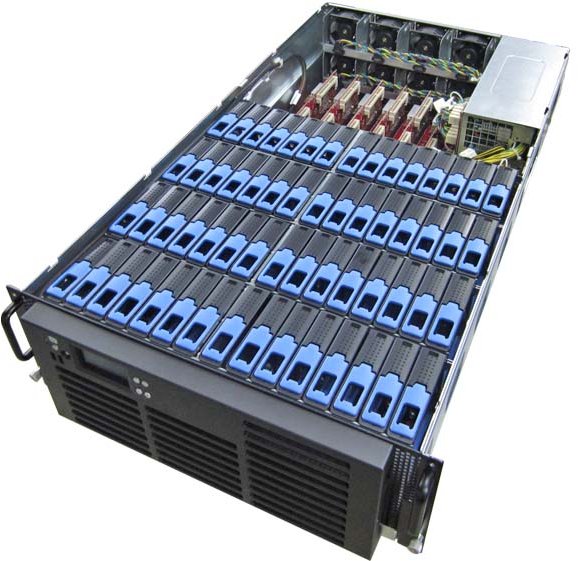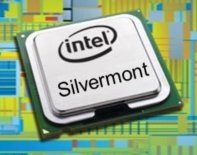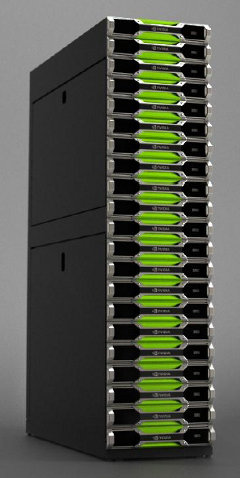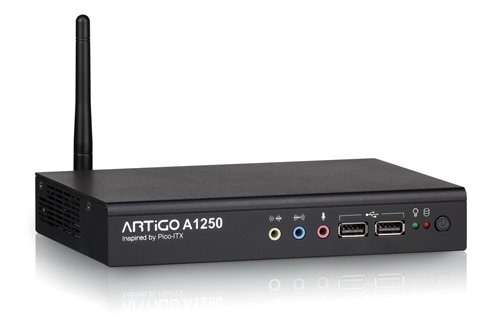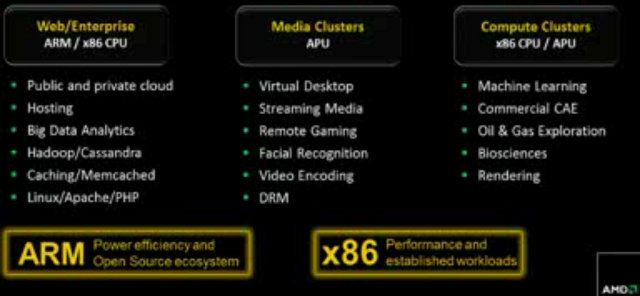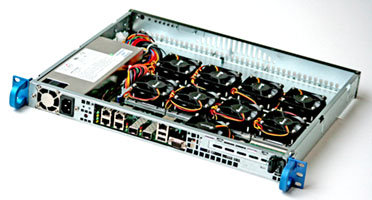ARM started to get involved in servers in 2011 with the announcements of Calxeda Energy Core, Marvell, and Applied Micro X-Gene Servers-on-a-Chip, and in 2012, products made by companies such as HP and Mitac started to appears. We’ve got to see some more ARM based servers this year thanks to Charbax, who filmed some Aaeon and Foxconn servers powered by Calxeda EnergyCore quad core ARM Cortex A9 SoC at Computex 2013. The first server is Aaeon Indus 1U cloud storage appliance: 1U Chassis 2x Calxeda Energycore nodes 10x 3.5″ HDD 2x 10 GbE uplinks and 4x 10GbE chassis-to-chassis interconnects Foxconn server shown at Computex has slightly higher specs: 4U chassis 12 Calxeda Energycore nodes 60x 3.5″ HDD for up to 240TB storage 4x 10 GbE uplinks and 6x 10 GbE chassis-to-chassis interconnects for 100 GbE total bandwidth There’s also a Gigabyte server, but I could get details. Server based on […]
Intel Takes on ARM with Silvermont Microarchitecture for Low Power SoCs
Intel has launched Silvermont, a new microarchitecture for low power SoC targeting smartphones, tablets, and servers in data centers. Silvermont SoC will be manufactured using 22nm Tri-Gate SoC process, and the company claims 3x times more peak performance than current generation Atom processors, or 5 times less power consumption at the same performance level. Silvermont will be used in Bay Trail, Avoton, and Merrifield processors: Intel’s quad-core “Bay Trail” SoC is scheduled for Q4 2013 tablets, and variants of the “Bay Trail” platform will also be used in market segments including entry laptop and desktop computers. Intel’s “Merrifield” is scheduled to ship to customers by the end of this year, and actual smartphones will show up in 2014. Intel’s “Avoton” will be used in low power microservers, and provide full server product capability that customers require including 64-bit, integrated fabric, error code correction, Intel virtualization technologies and software compatibility. Intel […]
Nvidia GRID Platform, Tegra 4 Processor and Project SHIELD Game Console at CES 2013
CES 2013 has finally started, and Nvidia has had a pretty amazing keynote with some PC gaming announcements such as “GeForce Experience” which is a piece a software that can configure your games settings automatically based on your PC hardware (e.g. processor and GPU), and 3 cloud and mobile devices announcements: Nvidia GRID Platform – Cloud Gaming Server with 240 Nvidia GPUs. Nvidia Tegra 4 – Nvidia 4 cores Cortex A15 , 72 GPU and SDR modem SoC for tablets and smartphones. Nvidia Project Shield – Game console with a 5″ display powered by Tegra 4 that can also act as a game controller, and play PC games on your TV. Nvidia GRID Platform NVIDIA GRID Cloud Gaming Platform is comprised of 20 GRID server per rack with a total of 240 Nvidia GPU capable of 200 TFLOPS or the equivalent of 700 Xbox 360. Nvidia GRID render 3D graphics […]
Linaro 12.12 Release with Linux Kernel 3.7 and Android 4.2.1
Linaro release 12.12 has just been announced, and includes Linux Kernel 3.7 and Android 4.2.1. The tracking version (stable release) uses Kernel 3.4.22. This release upgrades Android to version 4.2.1, Ubuntu images are now based on Ubuntu 12.10 (Quantal Quetzal) and Linaro U-Boot 2012.12 has been released with support for Origen 4 Quad and Arndale boards. Further improvements have been done for OpenEmbedded ARMv8, where they replaced the php Apache module by php-fpm among other things. On the kernel side, USB drivers have been refactored, and a kernel size analysis have been performed on several platforms. The power management team has mainly worked on big.LITTLE IKS and MP implementations, and it’s the first time LEG (Linaro Enterprise Group) is included in the release, and they worked on UEFI for ARM, GRUB for U-Boot, and provided a Ubuntu server image for Arndale board which can boot via UEFI or UBoot. Here […]
Intel Announces 3 Atom S1200 Low Power Server SoCs: S1220, S1240 and S1260
Intel has recently introduced the Intel Atom S1200 product family (Codename: Centerton) targeting high-density microservers (1000+ nodes per rack), and energy-efficient storage and networking systems. These new processors includes features such as error code correction, 64-bit support, and virtualization technologies required for use inside data centers, and consume as low as 6.1 watts. Three models are currently available: Intel Atom S1220 @ 1.6 GHz – TDP 8.1 Watts Intel Atom S1240 @ 1.6 GHz – TDP 6.1Watts Intel Atom S1260 @2.0 GHz – TDP 8.5Watts The SoCs include 2 physical cores and 4 threads enabled with Hyper-Threading Technology. The SoCs also include 64-bit support, a memory controller supporting up to 8GB of DDR3 memory, Intel Virtualization Technologies (Intel VT), 8 lanes of PCI Express 2.0, Error-Correcting Code (ECC) support, and other I/O interfaces integrated from Intel chipsets. Atom S1200 processors are manufactured using 32nm process technology. Intel also announced that […]
VIA ARTiGO A1250 Slim System Powered by Quad Core E-Series Processor
VIA Technologies announced the VIA ARTiGO A1250 slim system featuring a 1.0 GHz VIA QuadCore E-Series processor and VIA VX11H media system processor (MSP). The VIA ARTiGO A1250 is a low profile system targeted at home or office applications such as home server, home automation, hotel management, media streaming, digital signage, surveillance as well as medical and healthcare applications. Here are the key features of ARTIGO A1250: VIA QuadCore E-Series processor (U4650E) @ 1.0 GHz Up to 8GB of DDR3 1333 SDRAM SODIMM Supports one 2.5″ SATA HDD or Flash SSD installation Quiet, ultra slim profile design (3cm high) VIA VX11H media system processor with DirectX11 support 3D and HD video up to 1080p HDMI & VGA display ports with dual independent display support I/O: HDMI, VGA, 2x USB 3.0, 2x USB 2.0, GigaLAN, Audio-in/out/mic-in Average power consumption of 27W TDP Dimensions: 17.7cm x 12.5cm x 3.0cm I understand that inside […]
AMD To Provide 64-Bit ARM Opteron Processors for the Server Market
AMD announced it will design processors based on 64-bit ARM technology in addition to its x86 processors for the cloud and data center servers. AMD will be the first company to provide both x86 and ARM solutions to the server market, and the first ARM-based server CPU is scheduled for 2014. There aren’t much details at this time, but AMD did say it will be take advantage of AMD SeaMicro Freedom supercompute fabric in order to link CPU, Ethernet and Storage and the processor will be sold as an AMD Opteron CPU. Interestingly, the company does not plan to design 64-bit ARM processor for the client market (e.g. Windows RT) for the time being. Red Hat and AMD partnered for the server software, and Red Hat has started to work to bring support for the next generation of 64-bit ARM server processors to the Fedora Project include 64-bit ARM OpenJDK. […]
Codethink Launches The Baserock Slab ARM Server
Codethink has just announced an ARM based server called “The BaseRock Slab” powered by Marvell ARMADA XP quad core ARMv7-A processors with 2 GB RAM and 30GB (up to 120GB) mSATA SSD Storage per node, which targets applications such as cloud computing infrastructure and native ARM build and test. This 32 cores server comes in a 1U chassis (483mm x 44mm x 355m), is powered by a 260 PSU, integrates eight Cogent CSB1726-ArmadaXP SoM (Marvell Armada XP quad-core ARMv7-A CPUs, 1.33Ghz + 2 GB ECC DDR3 RAM) in to a carrier board featuring the following: 30GB (max 120GB) mSATA SSD, max 250MB/sec read/write, per SoM SATA port for additional dedicated storage, per SoM Dual 2.5Gbit/s full-duplex ethernet, trunkable into a single 5Gbit/s link Management SoM for remote power, fan and reset control Firmware upgrade via the network The server is managed by Cogent CSB1724 SoM powered by Marvell Armada 300 […]


